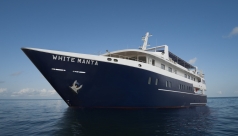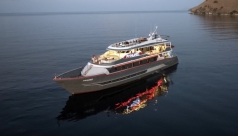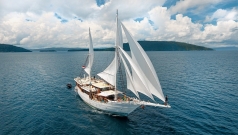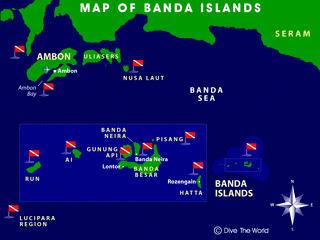Laha
About 3 kilometres inside the bay, on the northern coast, is the best macro dive site in Ambon called Laha. The reef here consists of a slope from 2 metres deep, overgrown with a few simple corals and rubble substrate, featherstars, fire urchins and sea squirts, on a sandy bed. The slope levels off a little at 12 metres before continuing down again into Ambon Bay's murky depths.
As you make your way into deeper water from the shallows, you'll see inquisitive black-saddled tobies considering your movements, and ringtail cardinalfish lurking motionless amongst the rubble. Small orange painted frogfish can be found perched on the coral branches, and shrimpfish and white cockatoo waspfish gently sway back and forth in the light water movement.
A little further into your dive, and you'll approach the nearby jetty, used by the local Ambon fishermen. Here you'll see loads of discarded rubbish and fish remnants from the fishing trawlers, scattered across the sea bed. This simple and accessible feast acts as an attraction for plenty of marine life. In this small area alone it's easy to spot up to 10 moray eel species - white eyed, snowflake, starry, undulated. you name it, it's here - and several species of lionfish and stonefish, including the evil looking spiny devilfish and spotted devilfish.
Glass bottles have become homes to striped fangblennies and catfish, fingered dragonets crawl across the sand, and sandperches squat on the rubble. Orbicular porcupinefish - the smallest species in its family - stare up at you with their innocent-looking eyes, and large trumpetfish stalk through this aquatic town. Take a close look at the spiny sponge branches in this section of the dive as you may be able to find pink thorny seahorses.
Then finally at a depth of around 10 metres and as dusk approaches, the waters of Ambon Bay come alive to the sight of mandarinfish performing their mating dance. These spectacularly coloured fish put on quite a show and, for most scuba divers, to witness this scene is worth the entrance money alone.
Rhino City
This site lies directly to the west of Laha and is an extension of the same sandy slope. It is named after the Rhinopias - a rare type of cryptic weedy scorpionfish that you can find here.
The slope is dotted with anemones - often carpet or bulb-tentacle varieties in Ambon. These are home to a delightful indigenous species of anemonefish which is black and white striped with pale yellow colouration on its belly. Divers should make a close examination of the anemones as they often house anemone shrimps and porcelain crabs, and ribbon eels are known to burrow close by too. Other types of brightly coloured crustaceans are common too, such as commensal and emperor shrimps, and arrow crabs. The very rare black razor shrimp has also been spotted here so ask your diving guide to show you one! Other interesting critters to find on the slope include hairy crabs and orang-utan crabs. Jawfish burrow in the sand and can be spotted fastidiously cleaning out the debris from their holes. Check out any sea grasses for the chance to find robust ghost pipefish and short-snout pipefish.
The shallows is a great place to spend the majority of the dive. Here you can rummage around to your heart's content, searching for nudibranchs, moray eels and dragonets.
Silale
On the southern city side of Ambon Bay, close to the bay's entrance, is a small settlement called Silale. The area has 2 dive sites - one being a dark sandy rubble slope, the other being a steeper slope of predominantly elephant ear sponges.
The rubble slope is a renowned area to see many varieties of frogfish. Orange, black and grey frogfish are all commonly seen here, lying in wait to ambush prey, such as small reef reef or even a dwarf lionfish. Large stonefish and scorpionfish can also be spotted by keen-eyed divers. Elsewhere on the slope, the spectacular wonderpus timidly ventures from one crevice to the next. Seahorses cling to branches and other debris on the sand, small schools of razorfish sway gently across the scene. The tiny Papuan cuttlefish is here in numbers; search near the foot of the mooring lines for these reclusive creatures.
The second dive site, a little further to the west, is more colourful and resplendent in yellow/green elephant ear sponges, often covered with small white sea cucumbers which feed on them. Look under the flaps of the sponges as giant green frogfish often lurk here. Leaffish seem to like this part of the bay too and you can find a variety of colours here - pink, cream, black, brown. Also in the area are cowfish, and twospot lizardfish - identifiable by the 2 'eyes' on their back behind their head.
Perhaps the highlight of this site are the many types of brilliantly coloured nudibranchs that live here. Ambon has a vast number of species for scuba divers to identify, including some huge blue dragons. Often found in the same habitat are pipefish and here you can find black ornate ghost pipefish, as well as the some of the more common types. Often found in deeper water are flying gurnards, crawling across the sandy substrate. Back in the shallows, mantis shrimp scamper around the rubble.


































